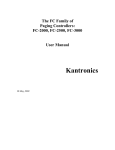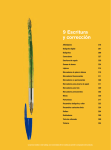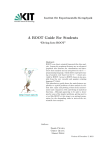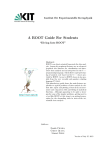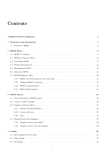Download INKA USER'S GUIDE Contents 1. Introduction 2 2
Transcript
INKA USER’S GUIDE
KIRILL LAPIDUS
Contents
1. Introduction
2. Histogrammer
2.1. Basic usage
2.2. Multiple file input
2.3. Arbitrary cuts
2.4. Secondary vertex cuts
2.5. Integral spectrum
2.6. Additional methods
3. Fitter
3.1. Basic usage
3.2. Changing the initial fit parameters
3.3. Reading/writing fit parameters from/into a file
3.4. Changing fit parameters for particular bins
3.5. Integral spectrum
4. Corrector
4.1. Basic usage
4.2. Multiple simulation files
4.3. Cuts
4.4. Employing the Geant info number
Date: January 26, 2012.
1
2
3
3
3
4
4
4
4
5
5
5
6
6
6
8
8
8
8
8
2
KIRILL LAPIDUS
1. Introduction
INKA is a class library that allows to make a differential analysis via invariant
mass (for example, KS0 → π + π − or Λ → p + π − )1. It includes three main classes:
Histogrammer, Fitter and Corrector.
The main feature of INKA is that a user doesn’t have to create/fill/save any single
histogram. Even in the case INKA is not suited for a particular analysis, you might
try the nifty Histogrammer class.
1There
is a way to use INKA for a single-particle analysis, please contact the author if you need
more information.
INKA USER’S GUIDE
3
2. Histogrammer
The task of this class is to produce histograms. As an input it takes a file (or files)
after the final analysis.
2.1. Basic usage. Let’s assume that you need to produce invariant mass distributions in 11 bins in y (rapidity) variable and 14 bins in pt (transverse momentum).
Then you would use Histogrammer like this:
//Create a Histogrammer object
//each histogram will have 250 bins in the region (0,1000) MeV
Histogrammer *hist = new Histogrammer(250,0,1000);
//Set input and output files
hist->set_input_output("/Users/klapidus/development/pNb35_NT_all_201011.root",
"/Users/klapidus/development/hist_output.root");
//Specify the name of the tree (ntuple) in the input file
hist->init("K0SNT");
//add variables (names of branches) which you’d like to study,
//specify numbers of bins and ranges
hist->add_variable("PtK0S",14,0.,1050.,"YK0S",11,0.36788,1.46788);
hist->execute(0); //0 -- all events in the input file
hist->finalize();
Note, that you should provide Histogrammer with the names of the variables in
the tree (branches); in the considered example they are PtK0S and YK0S.
Assume you’d like to make additionally an (mt , y)-analysis in the same time. Then
you add the following command to the script above:
hist->add_variable("MtK0S",15,500.,1500.,"YK0S",11,0.36788,1.46788);
Histogrammer also supports the one-dimensional case. This way you make a pt analysis:
hist->add_variable("PtK0S",14,0.,1050.);
Now all the necessary histograms are in the output file. What you usually need to
do next is to fit them in order to find background contributions and extract signals.
This is a job of Fitter (see section 3).
2.2. Multiple file input. In order to use several files as an input, one should use
the method Histogrammer::add_file. Note, that in this case one has also to use
the method Histogrammer::set_output. An example of usage:
4
KIRILL LAPIDUS
Histogrammer *hist = new Histogrammer(250,0,1000);
//Set the input and output files
hist->set_output("/Users/klapidus/development/hist_output.root");
hist->add_file("/Users/klapidus/development/input1.root");
hist->add_file("/Users/klapidus/development/input2.root");
hist->add_file("/Users/klapidus/development/input2.root");
...
2.3. Arbitrary cuts. To apply cuts to the data sample, use this method:
Histogrammer::add_cut(TString name, TString operator, Float_t value);
Let’s consider an example: you’d like to apply a cut on the ThetaK0S variable:
ThetaK0S < 30. In the same time, you’d like to fulfill the conditions N_Tracks > 3
and N_Tracks < 7. The following code will do the job:
Histogrammer *hist = new Histogrammer(250,0,1000);
...
hist->add_cut("ThetaK0S","<", 30); //add the first cut
hist->add_cut("N_Tracks",">", 3); //add the second cut
hist->add_cut("N_Tracks","<", 7); //add the third cut
...
hist->execute(0); //0 -- all events in the input file
All cuts you add in this way will be applied to all histograms, including the integral
spectrum (see below).
2.4. Secondary vertex cuts. To apply secondary vertex cuts there is a special
method:
Histogrammer::set_svertex_cuts(Float_t aVerDistX, Float_t aMinTrackDist,
Float_t aVerDistA, Float_t aVerDistB)
These cuts will be also applied to all histograms, including the integral spectrum
(see below).
2.5. Integral spectrum. It is useful to have an opportunity to produce an integral
spectrum, without any restrictions (except for the vertex or other added cuts). A
special method exists for this case:
Histogrammer::set_inv_mass_all(nbins, min, max)
nbins — number of bins you’d like to have; min (max) — minimum (maximum)
value of the variable.
If you use this method, then a folder named integral_spectrum will be created
in the output root-file.
2.6. Additional methods. To set the title of the X-axis:
Histogrammer::set_invmass_title(TString ainvmass_title)
INKA USER’S GUIDE
5
3. Fitter
3.1. Basic usage. In case you don’t need any special features, work with Fitter is
simple: you only need to specify the input file and which histograms you’d like to
fit.
//create a Fitter object
//250 is a minimum number of counts in the histogram
//380. and 600. define a range in which the fits will be performed
Fitter *fit = new Fitter(250, 380., 600.);
//input file (output of the Histogrammer)
fit->set_input("/Users/klapidus/development/hist_output.root");
fit->init();
fit->add_variable("PtK0S",14,0.,1050.,"YK0S", 11, 0.36788, 1.46788);
fit->execute();
fit->finalize();
After Fitter is done in the input file a folder named fit_PtK0S_YK0S (for the
considered example) with raw spectra will appear.
3.2. Changing the initial fit parameters. For the fitting of histograms the following 12-parameter function is used2:
y = par0*(
par3*(
par5 +
par9*(
TMath::Gaus(x,par1,par2) ) + //gauss1
TMath::Gaus(x,par1,par4) ) + //gauss2
par6*x + par7*x*x + par8*x*x*x + //polynomial
TMath::Landau(x,par10,par11) ); //Landau function
Two gaussians correspond to a signal, a background is fitted by a polynomial +
Landau function.
Initial values of parameters and their limits are set inside the code (fitter.cc).
There is a possibility to change them (globally, for all fits) in a user program with
the following methods:
Fitter::set_fit_param(Int_t n_fit_param, Float_t value)
Fitter::set_fit_param_limits(Int_t n_fit_param, Float_t value_min, Float_t value_max)
An example of usage:
Fitter *fit = new Fitter(250);
...
fit->set_fit_param(10, 525.);
fit->set_fit_param(11, 30.);
fit->set_fit_param_limits(10, 521., 529.);
...
fit->execute();
fit->finalize();
2At
the moment only this function can be used. Eventually, more flexibility will be offered.
6
KIRILL LAPIDUS
3.3. Reading/writing fit parameters from/into a file. Use this method to write
all obtained fit parameters into a file:
Fitter::write_fit_param(TString avarname1, TString avarname2, TString aoutput);
and this one to read fit parameters from a file (this way you set them as initial
values for the fit):
Fitter::read_fit_param(TString avarname1, Int_t anbins1,
TString avarname2, Int_t anbins2, TString ainput);
An example of usage:
Fitter *fit = new Fitter(...);
...
fit->read_fit_param("PtK0S",nptbins,"YK0S",nybins,"param_output1.txt");
fit->write_fit_param("PtK0S","YK0S","param_output1.txt");
...
Note that a file with fit parameters also contains fit ranges (parameters xleft and
xright) for every single fit, so you can modify it as well.
3.4. Changing fit parameters for particular bins. This method is not available anymore, since the needed functionality is completely covered by parameter input/output (see 3.3). Since the fit doesn’t always work perfectly, sometimes it is
needed to change the fit parameters for a particular bin. This is possible with the
method
Fitter::change_fit(Int_t j, Int_t i, Float_t axleft, Float_t axright)
where j and i define a bin. At the moment only the range of the fit can be
changed, but it is straightforward to extend the method. In future a more general
and flexible approach will be developed.
3.5. Integral spectrum. In 2.5 the way to produce an integral spectrum was explained.
With the method
Fitter::fit_integral_spectrum(Float_t afit_range_left, Float_t afit_range_right);
you can fit the integral spectrum (two parameters define the fitting range) and
with
Fitter::get_sig_bg_integral_spectrum(Float_t& signal, Float_t& bg)
extract the values of the signal and the background in the integral spectrum.
In case you need to access normalized χ2 (χ2 /NDF) of the fit, there is a method
Float_t Fitter::get_chi2_norm_integral_spectrum()
Example of usage:
...
chi2 = fit->get_chi2_norm_integral_spectrum()
...
INKA USER’S GUIDE
A method
Fitter::get_fit_param_integral_spectrum(Int_t n_fit_param, Float_t& value)
allows to access the value of a parameter after the fit of the integral spectrum.
7
8
KIRILL LAPIDUS
4. Corrector
4.1. Basic usage. Corrector requires three files: 1) a file with raw distributions
(delivered by Fitter), 2) a file with simulated (usually in 4π) particles (all necessary
variables, like PtK0S, YK0S should be in a tree), and 3) a file after final analysis
(symmetric to the experimental data).
//create a Corrector object
Corrector *corr = new Corrector();
//give a name of the tree
corr->init("K0SNT");
//set the input file with raw histograms
corr->set_raw_file("/Users/klapidus/development/hist_output.root");
//set an output file
corr->set_output("/Users/klapidus/development/corr_output.root");
//add a geant-cleaner file and a file after analysis
//"geant-cleaner" is a file with initial simulated particles
corr->add_file("/Users/klapidus/development/K0S_simDst_clean_shift.1.2.root",
"/Users/klapidus/development/pNb_K0S_simMicroDst_list_shift.root");
//set vertex cuts
corr->set_svertex_cuts(vdx, mtd, vda, vdb);
//add distributions you want to correct
corr->add_variable("PtK0S",nptbins,0.,1050.,"YK0S", nybins, yleft, yright);
corr->execute(0);
corr->correct();
4.2. Multiple simulation files. Corrector supports a possibility to use many input files with weights:
corr->add_file("simDst_clean_1.root", "channel1_final_analysis.root", 1.5);
corr->add_file("simDst_clean_2.root", "channel2_final_analysis.root", 7.6);
Note, that in case you don’t provide a weight, a default value of 1.0 will be assigned.
4.3. Cuts. In full analogy with Histogrammer, Corrector has methods to apply
secondary vertex and arbitrary cuts:
Corrector::set_svertex_cuts(Float_t aVerDistX, Float_t aMinTrackDist,
Float_t aVerDistA, Float_t aVerDistB);
Corrector::add_cut(TString name, TString oper, Float_t value);
4.4. Employing the Geant info number. To weight entries, which have a Geant
info number assigned, the following method should be used:
Corrector::add_channel_weight(Int_t geant_info_num, Float_t weight);
An example of usage:
Corrector *corr = new Corrector();
...
corr->add_channel_weight(3227810, 0.3325);
corr->add_channel_weight(1835783, 0.00147);
...
INKA USER’S GUIDE
corr->correct();
9









